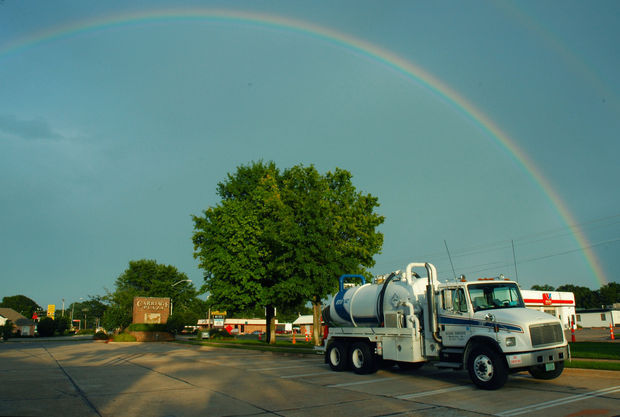Search: Site This Page
(405) 360-1552

| Ecovac Services / Projects / Gasoline / SURFAC Projects / |
Norman, Oklahoma
|
SITE LOCATION: |
Norman, Oklahoma |
|
CONTAMINATION: |
Separate-phase hydrocarbons (SPH – gasoline) up to 3.5 feet. Dissolved phase benzene shall be remediated to 0.294 mg/L. The free product remediation area was >2 acres encompassing approximately 42,000 yd3. |
|
GEOLOGY: |
Alluvial deposit consisting of clayey silty sand/sandy silty clay in the vadose zone, underlain by clayey sand/sandy clay in the saturated zone. |
|
HYDROGEOLOGY: |
Groundwater fluctuates across the site and seasonally at a depth of approximately 15 to 21 feet bgs. The hydraulic conductivity varied slightly (10-3 to 10-4 cm/s) across the site. |
|
SURFAC® EFFECTIVENESS: |
No SPH present since completion of the SURFAC® free product remediation on June 29, 2007. Dissolved phase BTEX has been significantly reduced across the site. Monitoring of the Phase 2 activities is currently occurring at the site. |
Background
EcoVac Services, Inc. was contracted by a consulting firm (under the direction of the Oklahoma Corporation Commission, OCC) to provide removal of gasoline SPH, and reduction of BTEX concentrations in the groundwater at the Former Pit Stop site in Norman, Oklahoma. The gasoline SPH plume emanated from two gasoline UST tank pits on two separate sites, the Former Pit Stop, and the former station at the current Wendy’s Restaurant site to the east of Pit Stop, as shown on the Site Map. The two releases have commingled on the Former Pit Stop site and then migrated toward the west. The plume lies beneath four properties on the north side of Main Street, beneath Main Street, and under a large strip center on the south side of Main Street.
EcoVac Services utilized its EFR® process in combination with its patented SURFAC® process to remove the SPH (free product) from the subsurface, and subsequently its patented ISCO-EFR® process to reduce the dissolved phase contamination in the groundwater.
Geology/Hydrogeology
The site is underlain by alluvial sediments. The geology consists of silty clay and sandy clay lenses in the vadose zone, grading into a clayey sand at approximately 15 to 17 feet bgs. The groundwater table fluctuates between 15 to 21 feet bgs during the year and across the site. The hydraulic conductivity is approximately 10-3 to 10-4 cm/s.
Remediation Methodology
EcoVac Services was contracted to implement SURFAC® and ISCO-EFR® at this site due to the relative speed in surfactant and chemical oxidant remediation. EcoVac Services’ patented SURFAC® process is the combination of dual-phase/multi-phase extraction and surfactant injection. EcoVac Services’ patented ISCO-EFR® process is the combination of dual-phase/multi-phase extraction and chemical oxidant injection. EcoVac Services employs its EFRÒ (enhanced fluid recovery) process for the dual-phase/multi-phase extraction component of EcoVac Services’ patented SURFAC® and ISCO-EFR® processes. The processes described herein are patent-protected and represents the intellectual property of EcoVac Services, Inc.
Phase 1 SPH (Free Product) Removal
EcoVac designed the remediation well network and provided oversight during installation. The remediation well network consisted of 129 remediation wells. Remediation field activities were then initiated on May 23, 2007 (EFR®) within 24 hours of contract execution. Table 1 summarizes the field activities by technology.
Table 1: Field Activities by Technology
|
Date |
Technology |
Purpose |
|
May 23 to June 11, 2007 |
EFR® |
To reduce the SPH thickness. |
|
June 12 to June 29, 2007 |
SURFAC® |
To remove all SPH. |
|
Present |
ISCO- EFR® |
To reduce dissolved phase concentrations. |
EFR® was implemented from May 23 through June 11, 2007. The purpose of EFR® was to reduce the SPH thickness and reduce the area of hydrocarbon contamination. SURFAC® was implemented from June 12 through 29, 2007. SURFAC® was implemented to completely remove the SPH. ISCO-EFR® has been subsequently implemented to reduce the dissolved phase contamination in the groundwater.
Results and Conclusions
- The EFR®/SURFAC® technologies implemented at this site completely removed the SPH from this >2 acre plume in less than 45 days. SPH existed at thicknesses up to 3.5 feet.
- EFR®/SURFAC® was implemented without restricting business at the five properties affected, and with minimal disturbance to the parking lots and lawns (i.e. no trenching).
- Chemical oxidant injection has continued to reduce the dissolved phase groundwater concentrations. Continued groundwater monitoring over the >1 year from complete SPH removal validates there has been no “spreading” of the SPH at this site.
